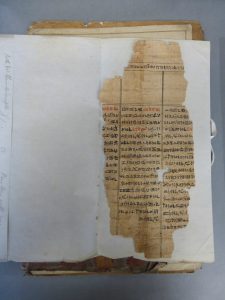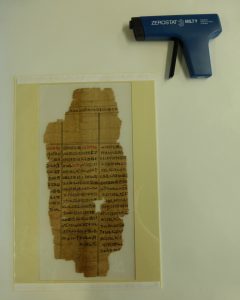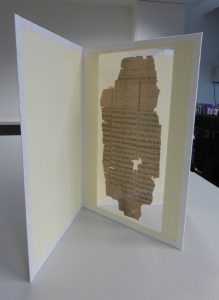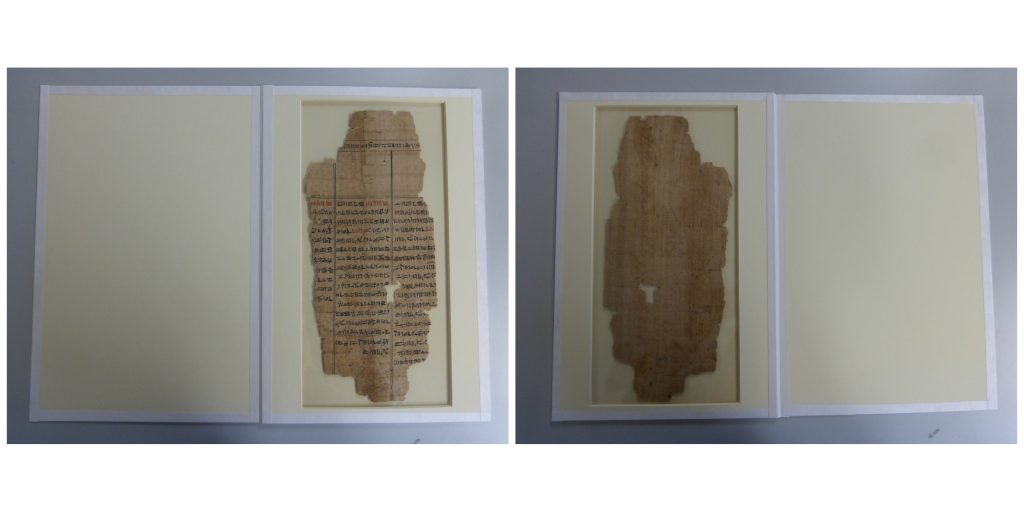It’s not every day that you are asked to conserve a magic spell on papyrus, but this is exactly what happened when I was asked to take a look an ancient fragment of text, recently discovered in the archive collections at the CRC.
The fragment was unearthed by an archives intern who was assessing the foreign language material in the David Laing collection. A vague catalogue entry labelling the box as miscellaneous languages, and an inscription on the folder wrongly identifying it as Chinese script, meant that this item had not been consulted for years and the staff were unaware of its existence. It has been suggested that it could be an Egyptian spell from the book of the dead, but further research is needed to confirm this.

Fragment of papyrus, before conservation
The fragment is in relatively poor condition, with a few tears and extensive losses. It has also become very brittle over time, so I wanted to rehouse this fragment in a way that prevents flexing and reduces handling, whilst allowing it to be examined easily. In the past papyrus has often been rehoused in between sheets of glass, however, this can be problematic as the construction is very heavy and can shatter if dropped. In this method the artefact is also in direct contact with the surface of the glass, which may cause the papyrus to adhere to it, making the removal of the fragment from its housing potentially very difficult. Furthermore, a whitish bloom can sometimes occur inside of the glass sandwich around the edges of the item. It has been proposed that this is caused by salts released from the papyrus (Banik and Stachelberger 1978)*. However, allowing a little air to circulate around the fragment can prevent this.
Due to these factors, we decided to house the artefact using a method similar to the polyester sling as described in an article entitled ‘Papyrus Storage at Princeton University’ by Stanley (1994). This provides lightweight, rigid protection for the item, whilst allowing it to be consulted without any direct handling. It is made by inserting the fragment between two sheets of polyester, which is then secured in place using a mountboard frame, with two sheets of mountboard either side so that the construction can be opened like a book and both sides viewed.
Before inserting the fragment into the polyester, static needs to be removed from the plastic. Static energy can attract the fragment to the polyester sheet, potentially causing the brittle papyrus to snap, as well as capturing dust. To remove the static, we use a Zerostat gun. The gun is held 30cm away from the polyester sheet and the trigger slowly pulled in, releasing positive ions. The trigger is then slowly released, emitting negative ions. This action can dissipate static energy from an area of 40 cm. This gun is also used by collectors of vinyl to ease removal from a turntable and aid removal of dust particles which can reduce sound quality when playing the record.

Papyrus fragment rehoused in polyester and mountboard frame with zerostat gun
The papyrus fragment can now be viewed more easily, and is ready for a researcher to discover the true meaning of this mysterious object.

Fragment rehoused

Papyrus, after rehousing. Front (left) and back (right) of fragment is shown
*Banik, Gerhard and Herbert Stachelberger, “Salt Migration in Papyrus Fragments”. Recent Advances in the Conservation and Analysis of Artifacts, Jubilee Conservation Conference Papers. Compiled by James Black, University of London Institute of Archaeology, 1978, 199-201.
Emily Hick
Special Collections Conservator

Pingback: Latest Library Links 23rd September 2016 | Latest Library Links
Pingback: Meet the Committee – Emily Hick | Conservation Conversations